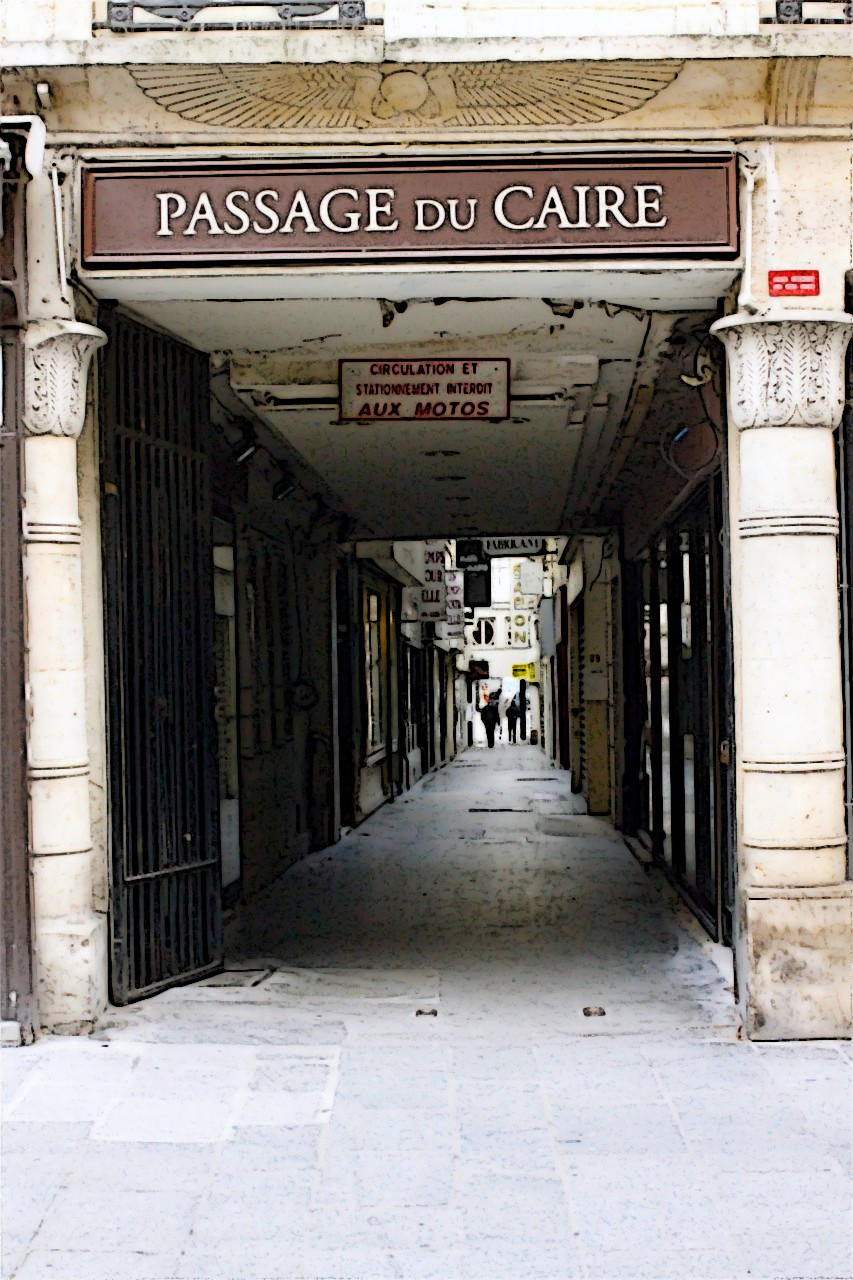Passage du Caire

Introduction: The Passage du Caire is one of roughly a dozen, surviving, glass-covered commercial arcades. At the beginning of the 19th century most of the streets of Paris were dark and muddy and lacked sidewalks. A few entrepreneurs copied the success of the Passage des Panoramas and its well-lit, dry and paved pedestrian passageways. By the middle of the 19th century there were about two dozen of these commercial malls, but most of them disappeared as the Paris authorities paved the main streets, added sidewalks and street-side gas lighting. According to some prominent historians, the Passage du Caire is not only the oldest of Paris' passages couverts, having been established a year before the still famous Passage des Panoramas, but the narrowest (sometimes no more than a meter wide) and most certainly the longest at three hundred and seventy meters end-to-end (1110 feet).
Mythography: In the beginning, Paris was a barbarian tribal town that was conquered by the Roman Empire and the location of the Passage du Caire or Cairo Alley passed through a region of forest sacred to pagan peoples of that ancient town. At the heart of the forest lay a sacred copse of oak trees surrounding a natural spring said to have healing properties. The Romans respected the holiness of the spring, and in their own way, they payed homage to the original gods of Paris by building a bath-house temple over the site.
As the centuries past, and the Empire converted to Christianity, so too was the Roman temple converted into a place holy to Christian values - a convent. Though there are no definitive records from that time, it is an accepted fact, that the convent of Filles-Dieu or God's Girls was established shortly after the fall of the Western Roman Empire. There is little question that the convent was built around and upon the old Roman bath temple and its sacred spring of healing waters. The original pagan legend of the sacred spring was grafted in total onto the Christian folk story of Mary Magdalen as the wife of Jesus, having escaped the dangers of Herodian Palestine along with her sister Martha and her brother Lazarus, thus traveling across the Mediterranean and then north to the small provincial trade town of Paris, to give birth to a son of Jesus who was then bathed in the sacred waters of the healing spring.
Regardless of the legends, the convent of Filles-Dieu did have a stone drinking fountain built sometime in the fourteenth century. In the centuries that followed, the fountain again gained the reputation for its healing properties and it became a local tradition for Parisian prostitutes to visit the fountain in the hopes of escaping the pains of the diseases of Venus. Accordingly, when a miracle did occur, the sisters of the convent were quick to offer the luck woman a chance to give up her sinful life and become a bride of the Son of God in thanksgiving. But the story of the convent, its repentant harlots and the miraculous waters that healed them, is not the end of this urban myth. For with the establishment of the glazed arcades, it is said, that the convent was torn down and the tombstones of the nuns were used to pave the passageway.
History: In 1798, the Parisian population was enthralled by Napoleon's campaign in Egypt. All things oriental and especially Egyptian became all the rage, and it was in this atmosphere that the streets surrounding the Passage du Caire were given Egyptian names to honor Napoleon. The passage was originally known as Passage de la Foire du Caire (Passage of the Fair of Cairo) and it was later shortened to Passage du Caire. It is commonly believed, that the intriguing hieroglyphic covered entrance facade with its three faces of Hathor was intentionally built to be the entrance of the covered arcade in imitation of the bazaars and souks of the Egyptian capital. During the 1840s, the passage was the center of thriving printer's trade, especially that of lithography, that was famous not only throughout Paris, but furthermore the entirety of France.
At the Moment: The Passage du Caire has become synonymous with the pret-a-porter (ready to wear) or wholesale fashion trade, that is currently dominated by cheap sweatshops owned and operated by a collage of destitute foreign nationals. Its most commonplace sight is of over-worked, sweaty foreign laborers carrying cardboard boxes to and from the passage, filled with cheap, mass produced clothing. Similar and affiliated industries also seem to thrive along the alcoves that line the passage, the most common of which include, but are not limited to inexpensive laundries, one or two room tailor shops and the booming production and trade in mannequins. At the turn of the twenty-first century, the passage came to the attentions of the Opération Programmée d'Amélioration de l'Habitat (Program for Improvement of the Habitat), of which, one of the objectives was to mettre en valeur le patrimoine architectural, notamment celui des passages (develop and enhance the architectural heritage, especially that of the passages). Sadly, with regard to the Passage du Caire, the program failed utterly and currently the passage is the most dilapidated of all the glass covered arcades still in existence.
- -- La Porte Bleue -- A shabby-chic tailor shop run by an obese Egyptian named Fouad Sultan.
http://www.peter-pho2.com/2010/09/passage-du-caire.html